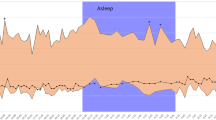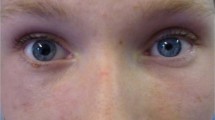Abstract
A controlled study of acute pharmacological intervention was designed to determine whether decreased sympathetic nerve activity in tetraplegic patients results in increased responsiveness of α-adrenoceptors which might contribute to vascular hyperreactivity and the clinical scenario of autonomic dysreflexia. The study took place in a university teaching hospital and included six male tetraplegic patients and six age-matched normal male controls. All tetraplegics were 5 months or longer post-traumatic spinal cord injury and all had experienced symptoms of autonomic dysreflexia on at least one occasion. The dorsal foot vein diameter was recorded with a tonometer during local infusions of noradrenaline 0.125–256 ng/min given through a short intravenous needle. In tetraplegic patients, there was a significant shift to the left of the dose—response curve indicating increased venous responsiveness to noradrenaline. The concentration of noradrenaline required to cause a 50% reduction of the resting vein diameter was decreased in tetraplegics (1.6 ng/min, geometric mean) compared to normal controls (10.9 ng/min,p < 0.02). α-Adrenoceptor responsiveness in dorsal foot veins is increased in patients with tetraplegia. Hypersensitivity of vascular α-adrenoceptors may contribute to autonomic dysreflexia in patients with high spinal cord injury.
Similar content being viewed by others
References
Mathias CJ, Frankel HL. Cardiovascular system in tetraplegia and paraplegia. In: Frankel HL, ed.Handbook of Clinical Neurology, Vol. 17 (61),Spinal Cord Trauma. Amsterdam: Elsevier Science Publishers, 1992; 435–456.
Mathias CJ, Christensen NJ, Corbett JL, Frankel HL, Spalding JMK. Plasma catecholamines during paroxysmal neurogenic hypertension in tetraplegic man.Circ Res 1976;39: 204–208.
Wallin BG, Stjernberg L. Sympathetic activity in man after spinal cord injury: outflow to skin below the lesion.Brain 1984;107: 183–198.
Debarge O, Christensen NJ, Corbett JL, Eidelman BH, Frankel HL, Mathias CJ. Plasma catecholamines in tetraplegics.Paraplegia 1978;12: 44–49.
Erickson RP. Autonomic hyperreflexia: pathophysiology and medical management.Arch Phys Med Rehabil 1980;61: 431–440.
Lindan R. Loiner E. Freehafer AAet al. Incidence and clinical features of autonomic dysreflexia in patients with spinal cord injury.Paraplegia 1980;18: 285–292.
Frankel HL, Hancock DO, Hyslop G, Melzak J, Michaelis LS, Ungar GH, Vernon JD, Walsh JJ. The value of postural reduction in the initial management of closed injuries of the spine with paraplegia and tetraplegia. I.Paraplegia 1969;7: 179–192.
Alradi A, Carruthers SG. Evaluation and application of the linear variable differential transformer technique for the assessment of human dorsal hand vein α-receptor activity.Clin Pharmacol Ther 1985;38: 495–502.
Arnold JMO, McLeod AP, Teasell RW, Brown JE, Carruthers SG. Increased venous α-adrenoceptor responsiveness in patients with reflex sympathetic dystrophy.Ann Intern Med 1993;118: 619–621.
Aellig.WH. Clinical pharmacology, physiology and pathophysiology of superficial veins — 1 & 2.Br J Clin Pharmacol 1994;38: 181–196, 289–305.
Hjelmdahl P, Daleskog M, Kahan T. Determination of plasma catecholamines by high performance liquid chromatography with electrochemical detection, comparison with a radioenzymatic method.Life Sci 1979;25: 131–138.
Wallenstein S, Zucker CL, Fleiss JL. Some statistical methods useful in circulation research.Circ Res 1980;47: 1–9.
Mathias CJ, Frankel HL, Christensen NJ, Spalding JMK. Enhanced pressor response to noradrenalin in patients with cervical spinal cord transection.Brain 1976;99: 757–770.
Braddom RL, Rocco JF. Autonomic dysreflexia: a survey of current treatment.Am J Phys Med Rehabil 1991;70: 234–241.
Krum H, Louis WJ, Brown DJ, Clarke SJ, Fleming JA, Howes LG. Cardiovascular and vasoactive hormone responses to bladder distension in spinal and normal man.Paraplegia 1992;30: 348–354.
Krum H, Brown DJ, Rowe PR, Louis WJ, Howes LG. Steady state plasma [3H]-noradrenaline kinetics in tetraplegic chronic spinal cord injury patients.J Auton Pharmacol 1990;10: 221–226.
Kongpatanakul S, Blaschke TF, Hoffman BB. The role of postsynaptic α2-adrenoceptors in human hand veins.Clin Res 1990;38: 94.
Kongpatanakul S, Blaschke TF, Hoffman BB. The role of postsynaptic α2-adrenoceptors in human hand veins.Clin Pharmac Ther 1990;47: 141.
Author information
Authors and Affiliations
Rights and permissions
About this article
Cite this article
Arnold, J.M.O., Feng, Q.P., Delaney, G.A. et al. Autonomic dysreflexia in tetraplegic patients: Evidence for α-adrenoceptor hyper-responsiveness. Clinical Autonomic Research 5, 267–270 (1995). https://doi.org/10.1007/BF01818891
Received:
Accepted:
Issue Date:
DOI: https://doi.org/10.1007/BF01818891




